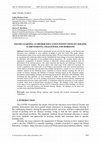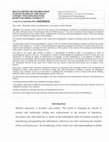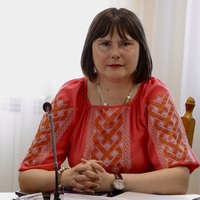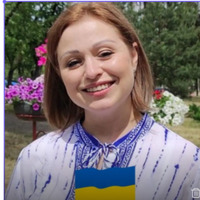Papers by Yuliya Krylova-Grek

Online learning at higher education institutions in Ukraine: achievements, challenges, and horizons, 2021
Online learning has shown considerable growth over the last decade, as the Internet and education... more Online learning has shown considerable growth over the last decade, as the Internet and education were combined to serve millions of people to gain new skills. This paper outlines benchmarking studies of the current online learning trends. We have demonstrated the weak points in organizing and conducting online classes, identified the shortcomings of excessive digitalization of education, and suggested several problem-solving alternatives. We strongly believe that the appropriate arrangement of distance learning is impossible without getting feedback from all participants of the learning process. Our study represents the benefits and challenges of distance learning noticed by students. The given study is the initial stage of the multi-level research. To receive a qualitative and valid result, we developed a questionnaire with cross-sectional questions, which allowed analysing each question from multiple perspectives, namely we were interested in students' opinion on the following issues: transition to entirely distance learning; the role of a teacher in distance learning; the influence of distance learning format on the education quality (perception, understanding, learning, and mastering the material); difficulties and challenges. After examining the data obtained, we have managed to single out the following aspects: the most advisable forms of ICT use in the learning organization; balance between learning workload and communication between teacher and student; coordination within the institution to avoid students' overload, which leads to demotivation and physical fatigue. The findings of this study indicate weak aspects in the organization and use of ICT in education. Based on these findings, we offered strategies for successful distance and blended learning. Besides, our findings can be taken into account when organizing blended learning.

Актуальні проблеми психології: Том V. Психофізіологія. Експериментальна психологія. Психологія праці". Випуск 21 , 2021
В статті охарактеризовано ‒ на підставі міждисциплінарного підходу до дослідження діяльності меді... more В статті охарактеризовано ‒ на підставі міждисциплінарного підходу до дослідження діяльності медіафахівця ‒ триступеневу схему комунікації: «суб’єкт-об’єкт-суб’єкт», в якій медіафахівець виступає як головний суб’єкт взаємодії, а сучасна аудиторія − і як об’єкт, і як суб’єкт комунікації. Розглянуто мету, завдання та особистісні настановлення комунікатора при оперті на аналіз продуктів його письмової діяльності ‒ текстів, які є незмінною константою, доступною для дослідження. Обґрунтовано доцільність розгляду діяльності медіафахівця як інформаційно-комунікативної за своєю сутністю. Така діяльність має здійснюватися з урахуванням низки зовнішніх факторів: демографічних чинників, мовленнєво-мовних параметрів; політичного устрою, соціальної структури суспільства; культурних та ментальних особливостей членів соціуму.

DisCo-2021 Proceedings of the 16th international conference, Prague: Active Learning in Digital Era: How Digital Tools promote a Conscious, Open-minded, Creative and Social-Oriented Thinking , 2021
Abstract
In the research, I examine the issue of the influence of the mass media on a person’s c... more Abstract
In the research, I examine the issue of the influence of the mass media on a person’s consciousness from a psycholinguistic perspective. The core focus of my current research is hate speech in print media.
The work was performed within an international project «Free voices: Promoting Independent Media in the Target Region» featuring the Crimean Human Rights Group. This paper presents an intermediate study of hate speech in the texts of online publications dated November 2020.
To receive data I combined the author's method of psycholinguistic analysis with a help of a software bot. Our research consists of four stages. During the first stage, a team of journalists and volunteers with the help of a software bot carried out search query mining to find negative information. Later, applying the author's method of psycholinguistic analysis of the text, we scrutinized the material obtained to identify the type of hate speech, its techniques of influencing consciousness.
The examples of hate speech were split into three types based on the use of specific linguistic and graphic tools: #1 direct hate speech; #2 indirect (hidden) hate speech; #3 manipulative hate speech.
The evidence from this study intimates that the media tend to use examples of hate speech of the second and third types and avoid direct discrimination.
In addition, there were mixed types: the combination of the second and third types and the combination of the first with the third or second type. I assumed the third and mixed#2-3 types of hate speech to be the methods of psycholinguistic manipulation. I have obtained comprehensive results proving that the majority of selected texts (75.7%) widely exploit methods of psycholinguistic manipulation.
Despite our investigations are still ongoing, and the presented results are interim, the considerable progress has been made in manifesting media trends and novel ways of influencing public opinion in the context of marginalization and hatred of certain groups in society. Although, the strong point of our study lies in specifying common methods and techniques of affecting audiences’ consciousness.
The results of this study will be used for a project report as well as to develop training for pre-journalist students and human rights defenders.
Актуальні проблеми психології, 2019
The paper focuses on translation of the semantic units in media texts as an inevitable part of in... more The paper focuses on translation of the semantic units in media texts as an inevitable part of information space. We pay attention that translation of information should be equal and transfer the sense. We stress the role of semantic units for correct conveying the context. It is well known that inaccurate translation is likely to distort the information and create an unequal picture of the world. Therefore, while transmission of information from a foreign language, we should take into consideration the psycholinguistic peculiarities of translation of semantic units.
Intelligent Human Systems Integration (Springer) , 2020
The paper discusses the possible impact of digital space on a human, as well as human-related dir... more The paper discusses the possible impact of digital space on a human, as well as human-related directions in cyber-security analysis in the education: levels of cyber-security, social engineering role in cyber-security of education, "cognitive vaccination". "A Human" is considered in general meaning, mainly as a learner. The analysis is provided on the basis of experience of hybrid war in Ukraine that have demonstrated the change of the target of military operations from military personnel and critical infrastructure to a human in general. Young people are the vulnerable group that can be the main goal of cognitive operations in long-term perspective, and they are the weakest link of the System.

Psycholinguistics , 2019
Introduction. The paper focuses on language means exploited by social engineers in their activiti... more Introduction. The paper focuses on language means exploited by social engineers in their activities in terms of humanitarian aspects of cybersecurity. The goal of this research is to analyze the methods and techniques employed by social engineers in their malicious activity and its features from a psycholinguistic point of view for further development of counteraction mechanisms. Methods. To obtain results we used the following methods: primary source analysis, analysis of spoken and written speech and speech products, and intent analysis. Results. The activity theory has been successfully applied to consider the key features of social engineers' work. On the base of AT we presented a three-component model which we may consider only in the case of a social engineer's successful attack (action). Based on the analysis of the sources, we distinguished the types of spoken and written communication actions (these types correspond to direct and indirect actions),

DisCo 2019. Proceedings of the 14th international conference in Prague, 2019
The paper describes a media literacy course, designed to master students' skills to verify photos... more The paper describes a media literacy course, designed to master students' skills to verify photos, images and icon-graphics used to illustrate information messages on the Internet. The classes were held on the campus of the State University of Telecommunications (Kyiv, Ukraine), students of 17-18 years old. It is important to say that we demonstrate the results of the first step of our research (students of the first year of studies) that concern images, photo and iconographies verification with mobile technology. Students learnt about the basic techniques and resources they can employ using mobile internet devices. We introduced students to free web-resources available on any mobile device. An obvious advantage of the course is that besides learning media literacy, it expands knowledge and experience in using pocket devices. This course promotes the development of analytical skills, critical thinking and the ability to collect and analyze information, improves the computer literacy level, and acquaints with free and accessible resources for verifying information. The survey results show before completing the course most students were not aware of the existence of special verification tools. Also, the majority of the respondents could not distinguish junk information from the authentic one, just using intuition and sensory-emotional perception. The surveys conducted after the course demonstrate that students realize that information that we are not sure about, or which is designed to influence our emotional-sensory sphere is better to be tested. The advantage of these lessons is that students learnt how to use mobile internet devices as useful tools for checking facts and images online. The results of the survey showed an increase in the media literacy level through the ability to analyze photo materials and iconographies with statistical data. After the training the students recognized the dominant role of mobile internet technologies for checking informationand learnt how to use them in practice. The authors highly recommend including the about to be mentioned classes in the general media literacy course.

Proceedings of the 15th International Conference on ICT in Education, Research and Industrial Applications. Integration, Harmonization and Knowledge Transfer. Ukraine, Kherson, June 12-15 , 2019
Media and information literacy is an essential skill in the Digital Age. Indeed, the lack of know... more Media and information literacy is an essential skill in the Digital Age. Indeed, the lack of knowledge and skills in media literacy is one of the reasons people are unable to analyse and evaluate information, thus creating a fertile breeding ground for unfair use of the World Wide Web. These days, people use information technologies to develop necessary insights and mindsets in order to appreciate adequately the overwhelming amount of information. Our purpose-designed Media and Information Literacy course lies at the core of freedom of expression and information. Prioritized information technologies empower learners to understand the functions of online resources, to critically assess their content, and to make decisions as users and producers of information and media content. The benefits from these technologies are obvious. They are extremely affordable, and the devices to implement them are always at hand.
This paper is in response to a call for input to a study of media and information literacy at the State University of Telecommunication (Kyiv, Ukraine). It covers the issues of applying information technologies to study media literacy. The ef-fective implementation of the course is based on the author’s unique approach, which includes the active use of a “media-creator” computer game, fact-checking methods, and special software. The media and information literacy course is regarded as a set of steps, as manifest in the paper. The obtained re-sults demonstrate that having attended an array of classes, having learnt theory, and having fulfilled practical tasks, students become more informed, sensitive, and aware of the information they receive on the Internet.

DisCo International conference on education, Prague, , 2018
The scholarly article is devoted to the analysis of psycholinguistic peculiarities of information... more The scholarly article is devoted to the analysis of psycholinguistic peculiarities of information education based on the study of the pilot course " Psycholinguistic Basics of Media Literacy ". The course is aimed at the development of analytical skills for understanding of the media content, comprehension of the basics of the psycholinguistic analysis of the text messages as well as development of logical and critical thinking. The notions of psycholinguistic analysis of the content and of manipulative content are introduced into the course for the first time. The proprietary method of the psycholinguistic analysis of the text includes the psychological methods of analysis like content analysis, intent analysis, etc. To add to it, the psycholinguistic approach presupposes the analysis of semantic units of the text, stylistic means and figures, meanings of words, utterances as well as analysis of the stylistics of the message and identification of the author's attitude to an event and persons, etc. The goals of the course shall include as follows: 1) development of analytical skills, 2) development of skills of psycholinguistic analysis of the text, 3) development of ability of understanding the mechanism of creation of fake news and advertorials, 4) forming the ability of identification of techniques of mind manipulation, 5) development of abilities of orientation in an information field, 6) raising personal responsibility for the actions in the Internet (writing posts in the social networks, blogs or spreading the information, adding ideas and comments). The course participants have to be able to analyse the information from the on-line space and to realize, how the content is built and which factors have an impact on this process. The course comprises three structural components aimed at the acquiring of the knowledge related to the mechanisms of building the content, improvement of orientation in media space and development of abilities to analyze the information coming to the consumer. In the run of the study we emphasize the development of skills of logical and critical thinking, analytical skills as well as skills of psycholinguistic analysis of the text. We provide the course spreading the knowledge in the field of information and communication education in the directions as follows:-developing analytical skills of the information messages analysis;-providing the opportunity to apply the psycholinguistic analysis of the text for identification of the goal, character and way of sending the message to the consumer;-teaches to identify the techniques and ways of manipulation in the text. The course can be applied in the open education system for the people interested in the basics of medialiteracy.

PSYCHOLINGUISTIC PECULIARITIES OF TRANSLATION OF SEMANTIC UNITS, 2017
The reserch is aimed at providing students with a comprehensive understanding of fundamental issu... more The reserch is aimed at providing students with a comprehensive understanding of fundamental issues in psycholinguistics and methods of text analysis within the psycholinguistic science, and to convey the necessary practical skills required for their application. It deals with the semantic units of the text and peculiarities of their performance from the point of view of psycholinguistics.
We consider a number of problems relating to Cultural studies and National psychology. It is believed that differences in the language image of the world are connected not only with the structure of language but also with the peculiarities of the national mentality and thinking.
We analyse semantic aspect of understanding and translation of the text of other language, in particular, the psycholinguistic peculiarities of translation of semantic units.
The name of the subject, the concept and the symbol are viewed as semantic units as they are the main components of the thought that are, from the point of view of psycholinguistics, are characterised by the qualities of the whole.
An adequate translation presupposes a complex approach. The translation of the thought is performed together with the text semantic units. Based on the semantic function, the semantic words can be divided into: name, concept and symbol.
Semantic units (name, concept, symbol) form a comprehensive construction encompassing the features of the object; they describe, depict the object, phenomenon, reflect the feeling, image, contain the information serving as a transition link between the feeling and the thought.
When performing a translation it is important to distinguish between the functions of semantic units and to define their semantic functional purpose in a certain context. The context depends on the extra linguistic factors, to which the following ones are referred to: viewing the context as the fact of human psyche; viewing the context depending on the speech, encyclopaedic, pragmatic content and background knowledge that have an influence on the building of the semantic level of consciousness; viewing an individual consciousness and sub-consciousness of an individual that thinks, speaks and acts.

Psycholinguistic Aspects of the Semantic Field of the Concept «War» in Modern Media Space., 2018
This paper presents modern trends in the change of the semantic field of the concept «war». Based... more This paper presents modern trends in the change of the semantic field of the concept «war». Based on the analysis of mass media in Russia, Ukraine and the USA, we demonstrated the regularities and interdependences of the mass media content and changes in the conceptual worldview of the people that consume information. We underlined the link between the changes in the forms of international conflicts and the increase of the units contributing to the semantic field of the concept «war». We analised how the information and communicative space effects the change of the conceptual (mental, cognitive) worldview of the public. Analysis of the semantic compatibility of the features of the concept «war» in mass media has revealed that apart from the military and armament themes, it contains the semantic units related to informational and psychological tools of influence. In the result of the systematic application of the concept «war» in relation to such semantic units as «informational»,
This article considers the way of effective solution of the conflict with the help of creative ap... more This article considers the way of effective solution of the conflict with the help of creative approach that means the activation of creative intellection. The factors that influence on the perception of conflict situation by person were considered. We pay attention to the notion “constructive intellection” and give example the way of solving of the conflict situations.
Крилова-Грек Ю.М. к.псих.н., ст. наук. співр. і-ту психології ім. Г. Костюка ПСИХОЛІНГВІСТИЧНІ АС... more Крилова-Грек Ю.М. к.псих.н., ст. наук. співр. і-ту психології ім. Г. Костюка ПСИХОЛІНГВІСТИЧНІ АСПЕКТИ НАВЧАННЯ ІНОЗЕМНОЇ МОВИ ДОРОСЛОЇ АУДИТОРІЇ. Мова -є одним з найважливіших засобів спілкування, та інструментом подолання мовних бар'єрів між представниками різних національностей. На сьогодні, знання іноземної мови, є одним
В работе рассмотрены межличностные конфликты, взаимообусловленность психологических установок уч... more В работе рассмотрены межличностные конфликты, взаимообусловленность психологических установок участников конфликта с паттернами поведения в рамках стратегий, используемых в конфликтной ситуации.
Цель исследования − выделить паттерны поведения в межличностных конфликтных ситуациях, рассмотреть взаимообусловленность психологических установок с паттернами, стратегиями и тактиками поведения в конфликтах.
This article provides a short summary of the political discourse from psycholinguistic point of v... more This article provides a short summary of the political discourse from psycholinguistic point of view. We give five main points of the political discourse analysis. In the article we show how our research can be used in practice.
Key words: political discourse, analysis, strategy, tactics semantics, marked words, symbols, audience, speaker.
This article is about the importance of semantic units for text translation. We indicate their ma... more This article is about the importance of semantic units for text translation. We indicate their main properties in the text.
Key words: semantic units, translation, name, concept, symbol.
This article covers the main regularities of the evolution of the concept “person” in European la... more This article covers the main regularities of the evolution of the concept “person” in European languages and the impact of economic and social-psychological factors on it.
Key words: person, personality, notion, concept, philosophy, human, psychology of personality, semantic field.
This article covers the main regularities of the evolution of the concept “person” in European l... more This article covers the main regularities of the evolution of the concept “person” in European languages and the impact of economic and social-psychological factors on it.
Key words: person, personality, notion, concept, philosophy, human, psychology of personality, semantic field.







Uploads
Papers by Yuliya Krylova-Grek
In the research, I examine the issue of the influence of the mass media on a person’s consciousness from a psycholinguistic perspective. The core focus of my current research is hate speech in print media.
The work was performed within an international project «Free voices: Promoting Independent Media in the Target Region» featuring the Crimean Human Rights Group. This paper presents an intermediate study of hate speech in the texts of online publications dated November 2020.
To receive data I combined the author's method of psycholinguistic analysis with a help of a software bot. Our research consists of four stages. During the first stage, a team of journalists and volunteers with the help of a software bot carried out search query mining to find negative information. Later, applying the author's method of psycholinguistic analysis of the text, we scrutinized the material obtained to identify the type of hate speech, its techniques of influencing consciousness.
The examples of hate speech were split into three types based on the use of specific linguistic and graphic tools: #1 direct hate speech; #2 indirect (hidden) hate speech; #3 manipulative hate speech.
The evidence from this study intimates that the media tend to use examples of hate speech of the second and third types and avoid direct discrimination.
In addition, there were mixed types: the combination of the second and third types and the combination of the first with the third or second type. I assumed the third and mixed#2-3 types of hate speech to be the methods of psycholinguistic manipulation. I have obtained comprehensive results proving that the majority of selected texts (75.7%) widely exploit methods of psycholinguistic manipulation.
Despite our investigations are still ongoing, and the presented results are interim, the considerable progress has been made in manifesting media trends and novel ways of influencing public opinion in the context of marginalization and hatred of certain groups in society. Although, the strong point of our study lies in specifying common methods and techniques of affecting audiences’ consciousness.
The results of this study will be used for a project report as well as to develop training for pre-journalist students and human rights defenders.
This paper is in response to a call for input to a study of media and information literacy at the State University of Telecommunication (Kyiv, Ukraine). It covers the issues of applying information technologies to study media literacy. The ef-fective implementation of the course is based on the author’s unique approach, which includes the active use of a “media-creator” computer game, fact-checking methods, and special software. The media and information literacy course is regarded as a set of steps, as manifest in the paper. The obtained re-sults demonstrate that having attended an array of classes, having learnt theory, and having fulfilled practical tasks, students become more informed, sensitive, and aware of the information they receive on the Internet.
We consider a number of problems relating to Cultural studies and National psychology. It is believed that differences in the language image of the world are connected not only with the structure of language but also with the peculiarities of the national mentality and thinking.
We analyse semantic aspect of understanding and translation of the text of other language, in particular, the psycholinguistic peculiarities of translation of semantic units.
The name of the subject, the concept and the symbol are viewed as semantic units as they are the main components of the thought that are, from the point of view of psycholinguistics, are characterised by the qualities of the whole.
An adequate translation presupposes a complex approach. The translation of the thought is performed together with the text semantic units. Based on the semantic function, the semantic words can be divided into: name, concept and symbol.
Semantic units (name, concept, symbol) form a comprehensive construction encompassing the features of the object; they describe, depict the object, phenomenon, reflect the feeling, image, contain the information serving as a transition link between the feeling and the thought.
When performing a translation it is important to distinguish between the functions of semantic units and to define their semantic functional purpose in a certain context. The context depends on the extra linguistic factors, to which the following ones are referred to: viewing the context as the fact of human psyche; viewing the context depending on the speech, encyclopaedic, pragmatic content and background knowledge that have an influence on the building of the semantic level of consciousness; viewing an individual consciousness and sub-consciousness of an individual that thinks, speaks and acts.
Цель исследования − выделить паттерны поведения в межличностных конфликтных ситуациях, рассмотреть взаимообусловленность психологических установок с паттернами, стратегиями и тактиками поведения в конфликтах.
Key words: political discourse, analysis, strategy, tactics semantics, marked words, symbols, audience, speaker.
Key words: semantic units, translation, name, concept, symbol.
Key words: person, personality, notion, concept, philosophy, human, psychology of personality, semantic field.
Key words: person, personality, notion, concept, philosophy, human, psychology of personality, semantic field.
In the research, I examine the issue of the influence of the mass media on a person’s consciousness from a psycholinguistic perspective. The core focus of my current research is hate speech in print media.
The work was performed within an international project «Free voices: Promoting Independent Media in the Target Region» featuring the Crimean Human Rights Group. This paper presents an intermediate study of hate speech in the texts of online publications dated November 2020.
To receive data I combined the author's method of psycholinguistic analysis with a help of a software bot. Our research consists of four stages. During the first stage, a team of journalists and volunteers with the help of a software bot carried out search query mining to find negative information. Later, applying the author's method of psycholinguistic analysis of the text, we scrutinized the material obtained to identify the type of hate speech, its techniques of influencing consciousness.
The examples of hate speech were split into three types based on the use of specific linguistic and graphic tools: #1 direct hate speech; #2 indirect (hidden) hate speech; #3 manipulative hate speech.
The evidence from this study intimates that the media tend to use examples of hate speech of the second and third types and avoid direct discrimination.
In addition, there were mixed types: the combination of the second and third types and the combination of the first with the third or second type. I assumed the third and mixed#2-3 types of hate speech to be the methods of psycholinguistic manipulation. I have obtained comprehensive results proving that the majority of selected texts (75.7%) widely exploit methods of psycholinguistic manipulation.
Despite our investigations are still ongoing, and the presented results are interim, the considerable progress has been made in manifesting media trends and novel ways of influencing public opinion in the context of marginalization and hatred of certain groups in society. Although, the strong point of our study lies in specifying common methods and techniques of affecting audiences’ consciousness.
The results of this study will be used for a project report as well as to develop training for pre-journalist students and human rights defenders.
This paper is in response to a call for input to a study of media and information literacy at the State University of Telecommunication (Kyiv, Ukraine). It covers the issues of applying information technologies to study media literacy. The ef-fective implementation of the course is based on the author’s unique approach, which includes the active use of a “media-creator” computer game, fact-checking methods, and special software. The media and information literacy course is regarded as a set of steps, as manifest in the paper. The obtained re-sults demonstrate that having attended an array of classes, having learnt theory, and having fulfilled practical tasks, students become more informed, sensitive, and aware of the information they receive on the Internet.
We consider a number of problems relating to Cultural studies and National psychology. It is believed that differences in the language image of the world are connected not only with the structure of language but also with the peculiarities of the national mentality and thinking.
We analyse semantic aspect of understanding and translation of the text of other language, in particular, the psycholinguistic peculiarities of translation of semantic units.
The name of the subject, the concept and the symbol are viewed as semantic units as they are the main components of the thought that are, from the point of view of psycholinguistics, are characterised by the qualities of the whole.
An adequate translation presupposes a complex approach. The translation of the thought is performed together with the text semantic units. Based on the semantic function, the semantic words can be divided into: name, concept and symbol.
Semantic units (name, concept, symbol) form a comprehensive construction encompassing the features of the object; they describe, depict the object, phenomenon, reflect the feeling, image, contain the information serving as a transition link between the feeling and the thought.
When performing a translation it is important to distinguish between the functions of semantic units and to define their semantic functional purpose in a certain context. The context depends on the extra linguistic factors, to which the following ones are referred to: viewing the context as the fact of human psyche; viewing the context depending on the speech, encyclopaedic, pragmatic content and background knowledge that have an influence on the building of the semantic level of consciousness; viewing an individual consciousness and sub-consciousness of an individual that thinks, speaks and acts.
Цель исследования − выделить паттерны поведения в межличностных конфликтных ситуациях, рассмотреть взаимообусловленность психологических установок с паттернами, стратегиями и тактиками поведения в конфликтах.
Key words: political discourse, analysis, strategy, tactics semantics, marked words, symbols, audience, speaker.
Key words: semantic units, translation, name, concept, symbol.
Key words: person, personality, notion, concept, philosophy, human, psychology of personality, semantic field.
Key words: person, personality, notion, concept, philosophy, human, psychology of personality, semantic field.
тодології і теорії психології Інституту психології імені Г. С. Костюка
НАПН України, характеризується культуротвірна функція психоло-
гічної науки. Ця функція знаходить конкретизацію, зокрема, у вдос-
коналенні педагогічної, наукової, економічної, політичної культури,
культури сімейних відносин тощо. У монографії окреслюються про-
відні аспекти впливу психологічної науки на формування патернів
(типових схем) свідомості й поведінки, притаманних окремим особам і людським спільнотам, та шляхи гуманізації такого впливу у різних сферах суспільного життя.
Книга адресується фахівцям у галузі психології та суміжних із нею
дисциплін.
методології і теорії психології Інституту психології імені Г.С. Костюка
НАПН України, аналізується у її різних вимірах категорія особистості,
одна з центральних у людинознавстві й, зокрема, у психології — акаде-
мічній і практичній. Дотримуючись раціогуманістичної світоглядної
й методологічної орієнтації та спираючись на здобутки різних напрямів
психологічної науки і суміжних із нею дисциплін, автори намагаються
досягти більш цілісного, інтегративного тлумачення вказаної категорії,
що має сприяти її ефективнішому використанню у наукових досліджен-
нях та у різних сферах соціальної практики.
Книга адресується фахівцям у галузі психології та суміжних із нею
дисциплін й усім, хто цікавиться методологією людинознавства.